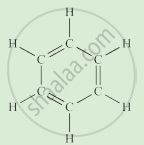Advertisements
Advertisements
Question
The correct structural formula of butanoic acid is
Options
Solution
Formula of butanoic acid is C3H7COOH.
APPEARS IN
RELATED QUESTIONS
What would be the electron dot structure of carbon dioxide which has the formula CO2?
Explain the nature of the covalent bond using the bond formation in CH3Cl.
Give the formula of the compound that would be formed by the combination of the following pair of elements:
K and H
Draw the electron-dot structure of HCl compound and state the type of bonding.
Explain why, diamond can be used in rock drilling equipment but graphite cannot.
A hydrocarbon having one double bond has 100 carbon atoms in its molecule. The number of hydrogen atoms in its molecule will be
(a) 200
(b) 198
(c) 202
(d) 196
What happens when methane (natural gas) burns in air? Write the chemical equation of the reaction involved.
Methane molecule is non-polar molecule. Explain.
Draw all possile structural formulae of compound from their molecular formula given below.
C3H4
Write answer as directed.
What causes the existance of very large number of carbon compound ?
Choose and write the correct option.
Which type of carbon-carbon bonds are present in Vanaspati ghee?
The molecule which contains a triple covalent bond is ______.
Compound X consists of molecules.
Choose the letter corresponding to the correct answer from the options A, B, C and D given below:
The type of bonding in X will be ______.
Explain the following:
Water is a polar covalent molecule.
Covalent bonds can be single, double or triple covalent bonds. How many electrons are shared in each? Give an example of each type.
The number of electrons in the valence shell of a carbon atom is 4.
Complete the following activity.
Write the names of the hydrocarbons for the following structural formula.
(isobutylene, cyclohexane, propene, cyclohexene, cyclopentane, benzene, propyne, isobutane, propane)
 |
Acetic acid was added to a solid X kept in a test tube. A colourless, odourless gas Y was evolved. The gas was passed through lime water, which turned milky. It was concluded that ______.
Carbon forms four covalent bonds by sharing its four valence electrons with four univalent atoms, e.g., hydrogen. After the formation of four bonds, carbon attains the electronic configuration of ______.
Explain dipole (polar) molecule by taking hydrogen chloride as an example.
